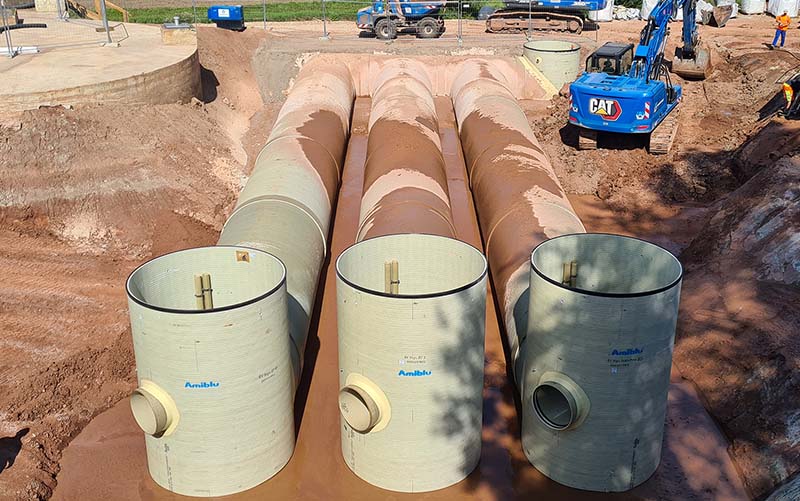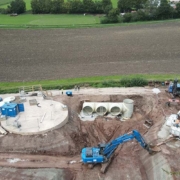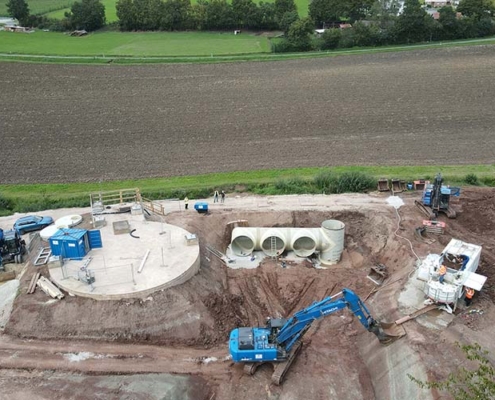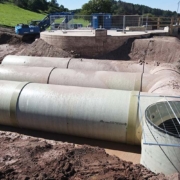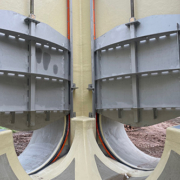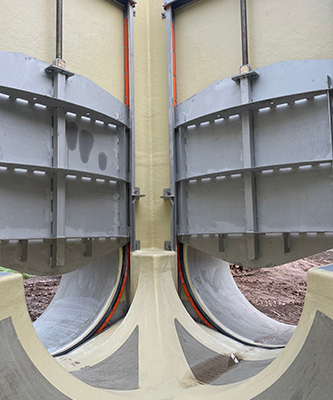Renovation of stormwater management system in Bavaria with Amiblu GRP
A common problem with wastewater systems is the corrosion of pipes and manholes and the comparatively shorter service life of old conventional materials. The Kronach-Süd wastewater association has therefore taken precautions. Only components made of corrosion-resistant glass fiber reinforced plastic (GRP) from Amiblu Germany GmbH are being used in the renovation of the Schmölz I pumping station and rainwater overflow basin in the Bavarian market town of Küps.
With the measures implemented in Küps, the Kronach-Süd wastewater association is tackling several problems at once. Structural inspections had shown that it not only the pumping station showed signs of age-related damage. The concrete rainwater overflow basin, which discharges combined wastewater into the nearby Krebsbach stream, was also in need of renovation. An inspection of the watercourse revealed an additional need for action: Massive washouts in the area of the discharge point – a clear indication that the discharge volumes from the combined sewer structure were too high. Hygiene articles that had been discharged into the water also drew attention to the lack of coarse material retention. The aim of SRP Schneider & Partner Ingenieur-Consult GmbH, Nuremberg, commissioned with the planning, was to rectify all these weak points in the best possible way.
Searching for the best solution
In addition to the classic concrete construction method, alternative building materials were examined with regard to their transportation, installation conditions and cost-effectiveness. It turned out that the use of GRP elements was the best choice in terms of the construction process, material service life and investment costs.
A new GRP storage channel with a total volume of 520 m3 will therefore be used as a stormwater overflow basin, while the existing concrete stormwater overflow basin will be renovated and converted into a stormwater retention basin with a storage volume of 300 m3. The new pumping station consists of horizontally and vertically laid GRP pipes DN 2600.
Amiscreen retains coarse material in the stormwater overflow basin
For the new stormwater overflow, three GRP pipes with a nominal diameter of DN 2600 are installed in parallel lines and connected to each other by a distribution and unification structure. With a length of 24.75 metres, the pipes store the combined wastewater during heavy rain. To prevent hygiene products from being discharged into the Krebsbach, each pipes contain two 14 m long Amiscreen elements with a nominal diameter of DN 600. These perforated elements are installed directly in the tank of the storage sewer and enable the retention of coarse materials. For this purpose, they are closed at the reservoir side and open into the upper part of the relief shaft. As this shaft is also closed towards the storage chamber, water can only flow in through the sieve elements and only flow out via the integrated overflow trough.
The combined wastewater is mechanically cleaned through the screen surface almost without pressure, unlike with a traditional screen. Thanks to the ring-shaped design, the screen surface largely exceeds the surface of a classic coarse material retention system (e.g. screening or rake systems). The risk of contamination or clogging of the screen surface is reduced to an absolute minimum. Coarse particles larger than 8 mm are retained by the screen surface without the use of external energy. They sink to the bottom and are transported to the wastewater treatment plant with the dry weather channel. “The location of the elements in the storage space enables an extremely large screening surface without losing any storage volume,” emphasises Walter Brandner, Head of the Wastewater Department at SRP Schneider & Partner Ingenieur-Consult GmbH.
There is no need to worry about the coarse material sticking to the screen surface, as Amiblu project engineer Marc Hirschmann adds:
“The Amiscreen system is located in the storage space at the level of the pipe axis. If the water level rises as a result of inflowing combined wastewater, the water flows slowly through the screen surface and then enters the GRP overflow shafts free of floating matter. Due to the very low flow velocity of 0.05 m/s, the particles are not pressed against the perforations and therefore do not clog the screen surface. The maintenance effort is reduced to a minimum.”
Existing structure is integrated
From the GRP overflow shafts, the combined sewage flows via a new DN 1200 GRP pipe section into the former rainwater overflow basin, which is equipped with a discharge throttle. “We wanted to utilise the old structure for wastewater retention in order to create more retention volume in the face of increasingly frequent heavy rainfall events. The retention capacity was supposed to be significantly larger according to the requirements. However, this could not be realised due to lack of space,” explains Brandner. A bypass pipe, also made of GRP with a nominal diameter of DN 1200, was installed for the duration of the renovation works on the existing structure. “It will remain in place even after the renovation of the circular rainwater retention basin and serve as an emergency bypass during e.g. inspections are of the basin,” explains Amiblu sales representative Jochen Auer.
Made to measure and centimetre
The commissioned construction company Karl Krumpholz Rohrbau GmbH, Kronach, is also satisfied with the decision in favour of GRP. The components could be moved by excavators without the need for a crane. The parts were prefabricated in the factory and then transported to the construction site on low-loaders. Site manager Stefan Becker:
“We no longer have to adapt anything on site. This makes a careful installation all the more important, as the entire GRP structure has already been manufactured to fit together. It is centimetre work. But as we have digitally marked out the target points and use the electronic excavator control system, this is not a problem.”
Less CO2 emissions through processing
The cohesive, inhomogeneous nature of the soil poses a greater challenge. Due to its poor compactability, an expert had declared the soil to be non-reusable. This is where a special proposal from Krumpholz for the 5,000 cubic metres of excavated material paid off.
“Our company has proven expertise with regard to temporarily flowable backfill material, also known as liquid soil. We developed the ‘recipe’ specifically for the conditions on site. By processing the excavated material as liquid soil, significantly fewer lorry journeys were necessary than with disposal and soil replacement. This saves costs, has only a minimal impact on the environment and therefore also reduces environmentally harmful CO2 emissions,” says Becker.
Due to the size of the construction pit, it was even possible to dispense with buoyancy protection for the installed GRP pipes. “We backfilled the excavation pit in several layers, each with approx. 500 litres of liquid soil. By filling the liquid soil in a controlled manner, we were able to achieve an even distribution in the excavation pit. Furthermore, the layer-by-layer filling of liquid soil prevented the GRP pipes from floating.”
The experience with GRP has been so positive that the Kronach-Süd wastewater association has planned further areas of application. A GRP solution is also being used in the current construction of a storage sewer at the Kronach-Süd wastewater treatment plant.

